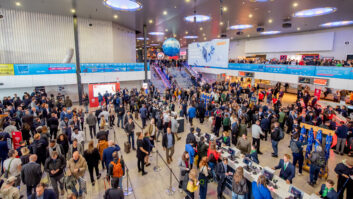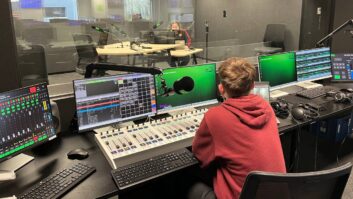When designing new radio studios, the first thing that comes to mind for many engineers is the console type and brand, followed by considerations of routing systems (if necessary).
But the second most expensive line item in a studio build is usually the furniture. Many furniture suites are completely custom, one-off designs and for that reason can be quite expensive. Others are based on more generic designs, and are thus more economical.
Here are some recent trends in studio furniture design and construction to consider for your next redesign.
DESIGNS HAVE CHANGED OVER THE LAST DECADE
Unless you are very new to the business you know that studio furniture designs have evolved right along with the technology used in radio stations. There’s a bit more to the story though, if you go back farther than that.

Radio stations (FM stations in particular) were often located by themselves — especially before the duopoly rule changes in the early 1990s. Some FMs were combined with AMs, so generally speaking, the most you would find in one location were two stations.
My first FM station posting didn’t have a “rack room” at all; there were two racks in the studio. All the gear for the station was either in one of those two racks, or in “turrets” that were part of the studio furniture. Modulation monitors and remote controls were often found within reach of the disc jockey’s chair position. Cart machines were all at eye level and within easy reach.
After the duopoly rule changes, and especially after the deregulation changes that came after 1996, more and more stations were clustered in to the same location, and thus the rack room was born, because there were enough common items used throughout (such as routers) that could be centrally located.

More and more centralized computer needs came about then as well (automation systems). Still, although racks disappeared from the studios themselves to a large extent, turrets were still included because space was needed to house all of the various devices, like hardware-based processors (harmonizers and parametric EQs) and all the various recording devices — such as MiniDisc, DAT and even cassette recorders — that needed to be at eye level. Another reason much of this kind of gear was elevated was to make room for turntable pedestals or large roll-around reel-to-reel tape decks.
FAST FORWARD TO THE 21ST CENTURY
Obviously, the use of computers in radio stations has eliminated the need for just about all of the items that were once found in the studio: cart machines, turntables, tape decks, DAT recorders and hardware-based processors. All that is needed in a studio now is the console (or control surface), computer monitors, a place for mouse/keyboard and microphone positions.

“It used to be that racks ruled and determined a lot of what went into radio studio furniture. With the miniaturization and movement of increasing functionality into the computer, monolithic racks are a thing of the past. Monitors, however, have proliferated. It’s common to see up to five monitors at board op positions, three at hosts, one or two everywhere else with laptops and iPads becoming ubiquitous for guests,” said David Holland, vice president of design for Omnirax furniture in Sausalito, Calif.
Thus, studio furniture looks very much different than it did 20, and even 10, years ago. Turrets are now rare in new studio furniture designs.

“…Used to be, what we call uppers — raised on ‘cable columns’ — were in virtually every studio. You still see them in production studios where frequently accessed rack mount gear needs to be close at hand, but the ubiquitous CD players and EAS devices units are either leaving, or getting tucked below the countertop. In studios where these are still deemed necessary, we’re often putting them to the side or behind the operator — available but not dominating the space,” said Holland.
Vince Fiola, president of Studio Technology, based in Kennett Square, Pa. , said, “The most apparent change [over the last 10 years] is the reduction of both above-counter and below-counter rack space. If there is even a need for an equipment rack above the counter, the placement has changed from easily accessible, to somewhere out of the way. Rack space below the counter top can be reduced due to the decrease in the amount of equipment and wiring needed. A well-vented, accessible cabinet to store computer hardware alongside a rack area is becoming more common. In cases where the systems are located in the TOC, and kept out of the studio, there is even less need for large amounts of cabinetry below the counter top. This allows for a much more open architecture design.”

Rod Graham, president of Graham Studios in Ft. Collins, Colo., agrees. “Trends in studio furniture have been dictated by technology advances in both the electronics and the software industries. As the broadcast components became smaller, we saw a reduction in the need for rack bays.”
ACCOMODATION FOR VIDEO
Because the internet has itself become a medium, radio has started using its capabilities more fully by generating video content and presenting it as a way of attracting and holding listeners and expanding the interactivity that has always been one of radio’s primary strengths. Consequently, studio designs now often have to accommodate characteristics that were formerly only important to TV.

“Sightlines have always been an important issue. In the old days, it was sight lines with guests, sidekicks, adjacent studios [such as the newsroom or control room], and today camera sightlines and angles are necessary as more and more stations are webcasting. Consequently, there is a need and want for low profile mic booms and monitor arms, and the industry has replied with some very nice and functional hardware,” said Mager Kizziah, president of Phoenix-based Mager Concepts.
“There is…an increased need for designing studio furniture to accommodate the sight lines needed for camera angles while maintaining the ability for the folks working in the studio to still be able to work and see each other,” said Fiola. “This usually requires things like mic arms kept low to the counter top and having computer monitors in wells or on arms below the counter top so the cameras can see over them.”

Holland said, “Visual Radio is here to stay and growing. As radio becomes a visual medium it requires that what is seen is as important as what is heard. These take several forms and a couple of differing strategies. One approach is to build radio’s version of TV stage sets, incorporating visual elements such as light boxes and embedded monitors for branding, while hiding radios specific gear behind shrouds and shields. Another is to make shows more conversational, but lowering the monitors into monitor ‘wells’ or ‘moats,’ so that, while present, the monitors don’t dominate the visual field and allow the camera to capture the action.”
FURNITURE CONSTRUCTION TECHNIQUES AND MATERIALS
Studio furniture needs to be built to last for at least 10 years of heavy duty wear and tear, regardless of the fact that most studios are no longer occupied more than six to eight hours per day. In any case, the furniture construction should be rugged enough so that it lasts as least as long — if not longer — than the consoles you decide to install.

“Materials developed in the last ten years have given furniture manufacturers more options,” said Graham. “Baltic Birch has become popular as an alternative to ‘T’ molding edge trim, as an example. The Baltic Birch gives the table top a wood trimmed quality look, without the expense of hardwood applications.” Fiola’s experience is a bit different: “As far as materials go, the standard building materials still apply. Plastic laminate, wood or plastic counter top edge or solid surface materials are the norm. As a custom furniture builder, I shy away from depending too much on computer-aided cutting machines. They can be helpful in some cases, but these machines are typically meant for reproducing the same piece over and over. There is usually an additional cost involved with getting a machine like this to make only one of something.”

“Materials are both changing and staying the same,” said Holland. “The vast majority of our builds still employ high pressure laminate because its attractive price point and long-lasting durability are tough to beat. We are seeing some increase in builds with Corian solid surface and have developed strategies and techniques to make this relatively expensive option more affordable. These include combining both HPL and Corian in a single build — in effect putting the money where the mouth is, as well as artfully eliminating costly field seaming by using precision CNC [computer numerical control] joinery to create mosaic countertops.”
CUSTOM APPLICATIONS
Even during this era of tight capital budgets, there are still plenty of custom design features that are requested of studio furniture builders.

Fiola described a few. In the creative/production studio end of things, we are being asked to maintain more counter work surface in the traditional console location by moving the mixing console into a secondary position off to the right or left. This enables the levels to be set on the board and allows a comfortable area in the traditional operator position to work on digital editing.
“Also, with the re-introduction of vinyl as a viable media in some parts of our industry, we are being asked to make room for turntables once again in some air studios.”

“There is a big surge of webcasting and podcasting that is bringing back nice studios and I hope it will let all furniture fabricators show their skills. Podcast studios and home studios are on the rise and a big portion of today’s broadcast,” said Kizziah.
“Branding has come to radio. We’ve move past simple signage and into full-on visual backdrops. Cumulus and ESPN have led the way with the former’s Nashville studios incorporating two such sets. Beyond what’s in the back [of the studio], we’ve done any number of things to increase branding and advertising opportunities. From built-in monitors fronting the aforementioned set pieces to laser cut legs to custom imprinted logos, we’ve been adding in opportunities for the camera to catch some eye candy and the potential advertisers to be wowed by,” said Holland.

Arrakis Systems says that its Accent furniture collection is notable for its beauty, function and durability. It highlights its aluminum frame, attractive panels and tabletops for broadcast studio applications.
Custom configurations enable users to decide what fits best for their needs, and the available custom features give it a fingerprint that is matchless, Arrakis says.
Arrakis has also introduced custom lighted panels, made using semi-translucent acrylic plastic that is durable and attractive. Colored backlighting will give a station a distinct and professional look.

The lighted panels are placed on the outside of the pedestal racks. These are available for the Balanced U, Unbalanced U, Short U, Long L and Short L configurations. Custom colors are available., according to the company.
Radio studio furniture continues to be a major line-item in the capital budget of studio builds and as such, the engineer in charge should carefully consider its design. Aside from accommodating the needs of the consoles and monitors, it needs to be rugged and able to take pounding from users that don’t seem to understand it needs to last a long time. Last but not least, it should look good, because users and visitors see it as part of the entire studio package. Consoles are designed to look cool, and the furniture that houses them should as well.







